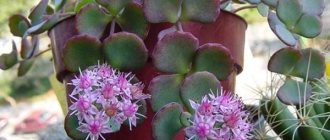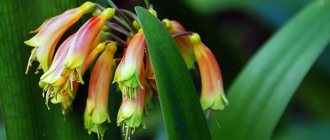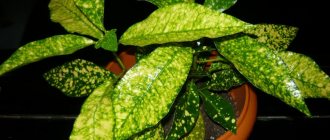There is real confusion in the minds of amateur flower growers with croton. They stubbornly call this a spectacular house plant, although in fact Croton grows in the wild or on tropical farms, where it is grown for medicinal purposes or to obtain seeds. And these are large trees or shrubs. In our houses it is not Croton that lives, but Codium. Moreover, only one species is the variegated codiaeum (Codiaeum variegatum) from the Euphorbiaceae family. In Europe it is often called "Joseph's cloak". There it became popular in the first half of the 19th century.
Codium variegated is an evergreen shrub that grows at home no more than 70 cm. Large (up to 30 cm) leathery leaves are arranged alternately on a straight branching trunk. The flowering is inconspicuous, the flowers are small, pale, the seeds are large. But the value of the plant is not in the flowers, but in the leaves - they have different shapes and incredibly beautiful colors: all shades of green, yellow, orange, red and even black! The decorative effect is enhanced by bright colored veins and spots (1).
There are at least 7 varieties of variegated codiaum, which differ in the shape of the leaf blade. For example, in the tortile form the leaf is heart-shaped with an elongated pointed tip, in trilobium the base of the leaf is deltoid, and the plate itself is divided into 3 parts.
general characteristics
Crotona flowers have erect stems of medium length. For a detailed acquaintance with a representative of the Euphorbiaceae family, the following description of the flower is better suited:
- Large, with a shiny surface, rich green in color with abundant splashes of yellow, bronze, and scarlet.
- Depending on the variety, the edge of the leaf blade may be wavy, smooth, or slightly jagged.
- The shape of the leaf blade can be very different: from round to oblong in the form of a lancet.
- Young leaves have a paler shade, which becomes richer as the leaf matures.
- During active flowering, axillary tassels are formed on the branches, each of which consists of several inflorescences of different colors.
Croton leaves grow upward, moving away from the stem at an acute angle, due to which the plant acquires a compact and original appearance.
Lighting requirements
The bright colors of croton leaves are the result of pigments produced through photosynthesis. This plant needs plenty of sunlight. In this case, direct sunlight can damage the surface of the sheet and cause burns.
To prevent such conditions, you should place a flower pot on windows with diffused light (in winter - the south side of the house, the rest of the time - the western and eastern sides). In summer, you can take the pot outside or onto the balcony in a shaded place.
Organization of watering
There are a few simple care rules that will help keep the plant healthy for a long time. How to water a flower correctly:
- Croton loves high air humidity, and therefore the leaves must be periodically wiped with a damp cloth. Regular spraying of the bush with a spray bottle will help ensure the proper level of humidity.
- In summer, an additional summer shower will be required.
- Watering is carried out on demand, as the soil in the pot partially dries. Do not allow water to stagnate in the flower tub, which can cause root rot.
For irrigation, use only settled water, the temperature of which is above the room range. Hypothermia of the roots when using cold water can lead to a decrease in immunity and the rapid occurrence of infectious diseases.
Pests and diseases
Croton is affected by mealybugs, nematodes, scale insects and spider mites, and most often by mites. It is difficult to say why croton attracts them so much, but sometimes fighting with them brings the owner of the flower to an extreme degree of irritation, and he, despairing of winning this fight, simply throws out the croton. But let me remind you: if you follow all the rules of care, your plants are not afraid of either insects or diseases, and the appearance of mites is explained by the fact that the croton was rarely washed and watered irregularly, so you only have yourself to blame for this kind of trouble.
You can fight spider mites, scale insects and scale insects by wiping the ground parts of the croton with a tobacco solution with added soap, which must be washed off after an hour and a half so that it does not get into the substrate.
In the photo: Healthy croton
Croton dropped its leaves
If the plant has dropped its leaves, it means it cannot drink. This happens if the roots are cold. Move the plant to a warm, bright place, adjust the moisture regime, allowing the earthen clod to dry a few centimeters deep between waterings, stop feeding the flower, spray the leaves well and put a transparent bag or cap on the plant.
All about azaleas in questions and answers
Why does croton dry out?
If only the lower leaves of a croton dry, then there is no need to worry: the gradual exposure of the lower part of the stem is a natural process for crotons. Dry tips of the leaves indicate that the plant suffers from low air humidity, and for croton a comfortable humidity level of 70% is comfortable. If the edges of the leaves dry out and brown spots appear on them, it means that the room is not warm enough and the croton is freezing.
If the croton's leaves not only dry out, but also fall off, then its roots definitely do not have enough moisture.
In the photo: A rare variety of croton
Why does it drop leaves?
Often readers of the site ask the question why croton leaves fall. We have already mentioned the first two reasons - chronically insufficient watering and low air humidity. This also happens when the room temperature is too low, as well as from temperature fluctuations or drafts.
What to do if croton leaves fall off?
- First, carefully re-read the rules for caring for croton.
- Secondly, analyze where and in what ways you violated these rules.
- Thirdly, correct your mistakes and prevent them from happening again.
Plant nutrition
Growing Croton at home requires mandatory fertilization of the soil in the flower pot. The presence of bright and large leaves, rapid growth of the bush and flowering require constant replenishment of nutrients in the soil.
Active fertilizing is used from early spring to late autumn. Complex mineral fertilizers can be found in specialized floriculture supply stores.
Home care
Croton (codium) is an unpretentious plant. But in order to achieve decorativeness and rapid growth of a flower, you will need to create comfortable conditions for it. The following agrotechnical measures will help with this:
- frequent but moderate watering;
- regular feeding;
- periodic transplantation;
- pruning;
- prevention of diseases and pests.
In addition, it is important to maintain optimal temperature and humidity in the room where croton is grown. How to care for the plant is described in detail below.
Regular bush pruning
The spectacular crown of croton requires regular pruning. It is this measure that allows you to maintain a neat and compact bush. Pruning is carried out according to the following scheme:
- The first pinching is carried out when the croton reaches a height of 15 cm.
- Subsequent pruning will be done as the bush reaches a height of 20 cm.
- Young flower stalks and buds are also removed, which take a lot of strength and energy from the bush.
The cut areas are immediately treated with charcoal or sulfur powder. Such indoor care is aimed at preventing the development of infectious diseases caused by viruses, bacteria and fungi.
Description
Indoor croton is considered a rather difficult plant to grow, which previously could only be cultivated in greenhouses. Through the efforts of breeders, more resistant varieties have been developed that adapt well to home conditions.
Variegated Croton is the most commonly grown species. Interesting color variations of its varieties:
- "Excellent"
- "Petra"
- "Miss Iceton"
- "Reidii"
- "Bravo".
Varietal forms with a golden pattern:
- "Goldfinger"
- "Golden Bell"
- "Golden Star",
- "Golden Bell"
- "Sunny star"
- "Gold sun"
- "Golden King".
The miniature variety “Mammi” in red-beard tones and the very unusual variety of the variegatum line “Zanzibar” with narrow and long multi-colored foliage look impressive.
With proper care, you can see croton blooming, which has no decorative value.
Croton transplant rules
The Croton houseplant must be replanted once every 6 months. Older representatives are transplanted once every 2 years. Rules for optimal transplantation:
- The new pot should not differ much in width from the old container.
- Due to the high sensitivity of croton to infectious diseases, the pot should first be washed and doused with boiling water to destroy pests, spores, and bacteria.
- A drainage layer in the form of expanded clay is laid on the bottom of the pot. Such drainage will retain moisture in the required amount, without creating conditions for stagnation of water.
- A mixture for planting croton is placed on top of the drainage layer. Its composition must necessarily include peat, sand, turf and leaf humus.
- Transplantation is carried out using the transshipment method.
The plant is carefully removed from the old pot along with a lump of earth. The roots are carefully examined for the presence of pests, signs of damage and diseases. Remove damaged roots. At the same time, it is important to try not to destroy the earthen lump on the roots of the croton. Place the plant in a new container and sprinkle with soil.
Air humidity
In its natural environment, croton lives in tropical rainforests, so for normal growth and development of the flower it is important to create similar conditions. A special device – an air humidifier – will help with this. If you do not have such a device, then place containers filled with water next to the pot. In addition, in winter, keep the plant away from central heating radiators and other heat sources.
Regularly spray the codiaum foliage with warm water from a spray bottle and wipe them from dust with a damp sponge. In summer, carry out this procedure 2-3 times a week, in winter – 2 times a month. During the hot season, give your pet a warm shower. But make sure that water does not get on the soil. To do this, wrap the pot in polyethylene.
Reproduction methods
Croton can be propagated in several ways, each of which has a number of advantages and disadvantages.
The first technique is to plant seeds. For planting, it is necessary to use only seed material collected the day before, because croton seeds very quickly lose their properties (they are not resistant to unfavorable environmental conditions).
In addition, the resulting hybrids will be strikingly different from the mother plant (rapid modification of phenotypic characteristics). Croton seeds are pre-soaked in hot water for 30 minutes, then the material is left to swell for 24 hours.
Planting in the ground is carried out to a depth of 1 cm, and moistening is carried out using the method of bottom watering. Caring for young plantings after picking does not differ significantly from caring for an adult plant.
Cuttings are also a very popular method of propagating a bush. For this purpose, apical cuttings 10 cm long are cut off. The cut areas are treated with running water and then left in the open air to dry. Soak the cuttings in a growth stimulator for the time recommended by the instructions, and then plant them in a new pot with soil.
Features of flowering
It is difficult to make croton bloom: this requires both proper care and systematic feeding. However, there is no need to strive for this, since the flowers of this plant are small and inconspicuous.
Croton's inflorescences are yellow-white (sometimes pink) and most closely resemble linden flowers. The flowering period is long, and the buds open within a few hours, gradually and a little chaotically. The faded ones fall off, and new ones form in their place.
It must be remembered that croton is primarily valued for its leaves. Flowers consume a lot of nutrients and take away the vitality of the plant. Therefore, many gardeners prefer to immediately pick off the inflorescences so that they do not interfere with the plant’s normal development.











